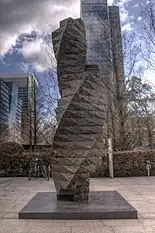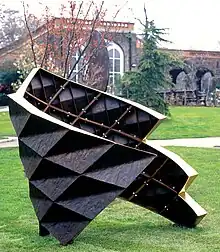

Charles William George Hadcock is a British sculptor[2] (born 1965 in Derby, England) known for his monumental sculptures that incorporate elements of geology, engineering, and mathematics. Hadcock's work also draws inspiration from music, philosophy, and poetry. He is a Deputy Lieutenant of Lancashire.
Charles Hadcock sculptures can be found in a variety of public and private collections around the world. His works are often large in scale and are made from a variety of materials, including steel, stone, and bronze. Two sculptures, "Helisphere"[3] and "Torsion II",[4] are exhibited in Canary Wharf Art Trail, London.
Education
Charles Hadcock studied at Ampleforth College 1979–1983, Derby College of Art & Technology 1983–1984, Cheltenham College of Art 1984–1987, Royal College of Art 1987–1989.[5][6][7]
Career

Charles Hadcock's work incorporates aspects of the natural world, geology and engineering, either overtly or covertly. Finding that the mathematical formulas for shapes observed within the natural world are often the source for solving engineering design problems, Hadcock has incorporated these ideas both at first and at second hand into components for his sculptures. His direct observation of rocks becomes a source for the surface of his sculptures while mathematics inform how a sculpture may be achieved with multiple castings of a single form. Hadcock's works are imbued with a visual vitality so that the sculptures remain free, dynamic, unrestrained, and immediate.[8]

Hadcock prefers to work on his own sculpture rather than rely on production facilities so that the eye and hand of the artist is apparent in every work. His belief is that his knowledge, skill, and techniques are constantly evolving, informing each piece he makes.
Investigating Multiples, a 1996 solo exhibition in London at Reed's Wharf Gallery[9][10] followed the siting of Caesura IV[11][12] at Sculpture at Goodwood. His first monumental public commission in 1997, Passacaglia,[13][14][15] came after a national competition for a permanent work to be installed on Brighton Beach. Controversial initially, Passacaglia is now an iconic feature of the Brighton beachfront.
A 1999 exhibition of Hadcock's drawings and maquettes If in doubt, ask at London's Imperial College[16][17][18] was part of a drive by the university to encourage engineering students to learn about the arts. There is 1 in all of us[19][20][21][22] was a collaboration with soundscape engineers at the Gardner Arts Centre, University of Sussex, whilst the Peter Scott Gallery at Lancaster University had to find additional exhibition space outside the gallery in 2006.[23]
Hadcock was included in the 1999 exhibition of British sculptors Shape of the Century at Salisbury Cathedral and Canary Wharf,[17][24] which was followed by inclusion in Bronze: Contemporary British Sculpture,[25] a group show to celebrate the millennium and the tradition of siting bronze sculptures in London parks. Hadcock's monumental bronze, Caesura VI, was installed and remains in situ in Holland Park, London.
At this time Hadcock moved his studio from London to Lancashire, as he required additional space and facilities to enable the production of the monumental works being frequently commissioned for locations around the country.
Hadcock has on occasion produced commissions, such as a monument to commemorate film director, James Whale, erected in 2001 on the grounds of a multiplex cinema in Whale's hometown of Dudley, and the installation of a sculptural gate and railings around a development in Central London.
Hadcock's exhibition program continued with a solo show at Canary Wharf in 2003, followed by a second larger solo show in 2011.[26][27][28] He showed in Sotheby's Beyond Limits exhibition at Chatsworth House in 2011[29] and 2016[30] and in independent solo exhibitions in London[31] at 60 Threadneedle Street in 2015,[32][33] in the award-winning Eric Parry Architects designed foyer, and in a pop-up gallery near Green Park with the solo exhibition, Fusion, in 2016.[34][35]
Business
Charles Hadcock is a director of Roach Bridge Tissues, a Lancashire-based manufacturing company specializing in bespoke printing and conversion of tissue wrapping paper.[36]
Between 2008 and 2012, he managed the development and installation of a hydro-electric power generating station at Roach Bridge Mill, Lancashire, where he is also the development director for an ongoing project to create a new business village on the historic mill site.
Hadcock is Chairman of Creative Lancashire,[37] a public and private sector initiative to encourage and support all the creative industries in Lancashire.
Past projects include the development and management of The Watermark Studios,[38] a mix of office and studio space in Preston (2001–2009).
Awards
Charles Hadcock received The Queen's Award for Enterprise Promotion on April 21, 2007.[39]
Hadcock was commissioned a Deputy Lieutenant for Lancashire in 2014.[2]
References
- ↑ Charles Hadcock: Torsion II Canary Wharf Art Trail. Canary Wharf Group. Retrieved 22 February 2023.
- 1 2 "Official Public Record" (PDF). The London Gazette. 21 April 2007.
- ↑ Charles Hadcock: Helisphere Canary Wharf Art Trail. Canary Wharf Group. Retrieved 22 February 2023.
- ↑ Charles Hadcock: Torsion II Canary Wharf Art Trail. Canary Wharf Group. Retrieved 22 February 2023.
- ↑ "William Feaver encounters grandiose statements among the students at the RCA". Vogue. 1 June 1989.
- ↑ Lucie Smith, Edward (12 June 1989). "Contemporary Art Market". The Independent.
- ↑ Packer, William (13 June 1989). "Royal College of Art Degree Show". Financial Times.
- ↑ "Charles Hadcock » Artists » Royal British Society of Sculptors". rbs.org.uk. Archived from the original on 15 February 2018. Retrieved 14 February 2018.
- ↑ Elliot, Ann (1996). Investigating Multiples. ISBN 1899268065.
- ↑ Lambirth, Andrew (22 May 1996). "Pick of the Week". What's on in London.
- ↑ Bamber, Roger (19 December 1995). "Home News". The Guardian.
- ↑ Sculpture at Goodwood. British Contemporary Sculpture. 1996. pp. 96, 97. ISBN 0952523310.
- ↑ Windsor, John (20 March 1998). "Sculptor Shapes up on the Beach". The Independent.
- ↑ "Sculpture 98, Passacaglia – Brighton Beach". Royal Society of British Sculptors. 1998.
- ↑ Weld, Fay (3 September 1999). "Welds Apart". Design Week.
- ↑ Farmelo, Graham (14 February 1999). "The Sounds of Silence in a new Blairopolis". The Independent on Sunday.
- 1 2 Lambirth, Andrew (1 July 1999). "Andrew Lambirth Reviews Graham Sutherland and Charles Hadcock". London Magazine.
- ↑ Windsor, John (26 January 1999). "John Windsors Guide to Collecting Contemporary Art: This Week Charles Hadcock". The Independent.
- ↑ Hall, Sally (3 November 2000). "Learning Curve is an Inspiration for Sculpture". The Argus.
- ↑ Merrick, Jay (29 May 2001). "Designs that show their True Metal". The Independent.
- ↑ Sweet, Fay (3 February 2003). "Art is the Business". London Evening Standard.
- ↑ Elliot, Ann (1 December 2000). "Pick of the Year". Galleries Magazine.
- ↑ Chapman, Peter (12 May 2006). "Art: Private view". The Independent.
- ↑ The Shape of the Century – 100 years of Sculpture in Britain. Canary Wharf Group.
- ↑ Bronze: Contemporary British Sculpture. Royal Borough of Kensington and Chelsea. 2000.
- ↑ "Art: Charles Hadcock, New and Revisited Sculptures". Canary Wharf Magazine. 1 March 2011.
- ↑ "Visual Arts, Last Chance to see". Canary Wharf Magazine. 1 May 2011.
- ↑ Lambirth, Andrew (1 April 2011). "Books and Art". The Spectator.
- ↑ "Ancient and Modern". The Daily Telegraph. 11 September 2011.
- ↑ "Chatsworth House: Hadid sculpture part of annual exhibition". BBC. 10 September 2016.
- ↑ Winter, Lydia (21 August 2014). "Encounter Contemporary: avant-garde e-gallery". How To Spend It (Financial Times).
- ↑ "Charles Hadcock. Elements". The Wall Street Journal. 27 March 2014. Retrieved 1 October 2016.
- ↑ Lambirth, Andrew (5 July 2014). "Exhibitions: Mixed Blessings". The Spectator.
- ↑ "'Fusion' Exhibition of Sculpture Artist Charles Hadcock". Ikon London Magazine. 30 October 2016. Retrieved 23 February 2018.
- ↑ Milner, Catherine (17 October 2016). "Charles Hadcock breaks with form at Encounter Contemporary". Financial Times: How to Spend It. Retrieved 17 October 2016.
- ↑ "Charles Hadcock - the internationally-renowned sculptor from Samlesbury". October 2015.
- ↑ "Charles Hadcock FRBS". Creative Lancashire.
- ↑ "Business Insight". Design Week. 9 August 2007.
- ↑ Arnold, Harriet (21 April 2007). "Emphasis on Helping Others Get It Right". Financial Times.